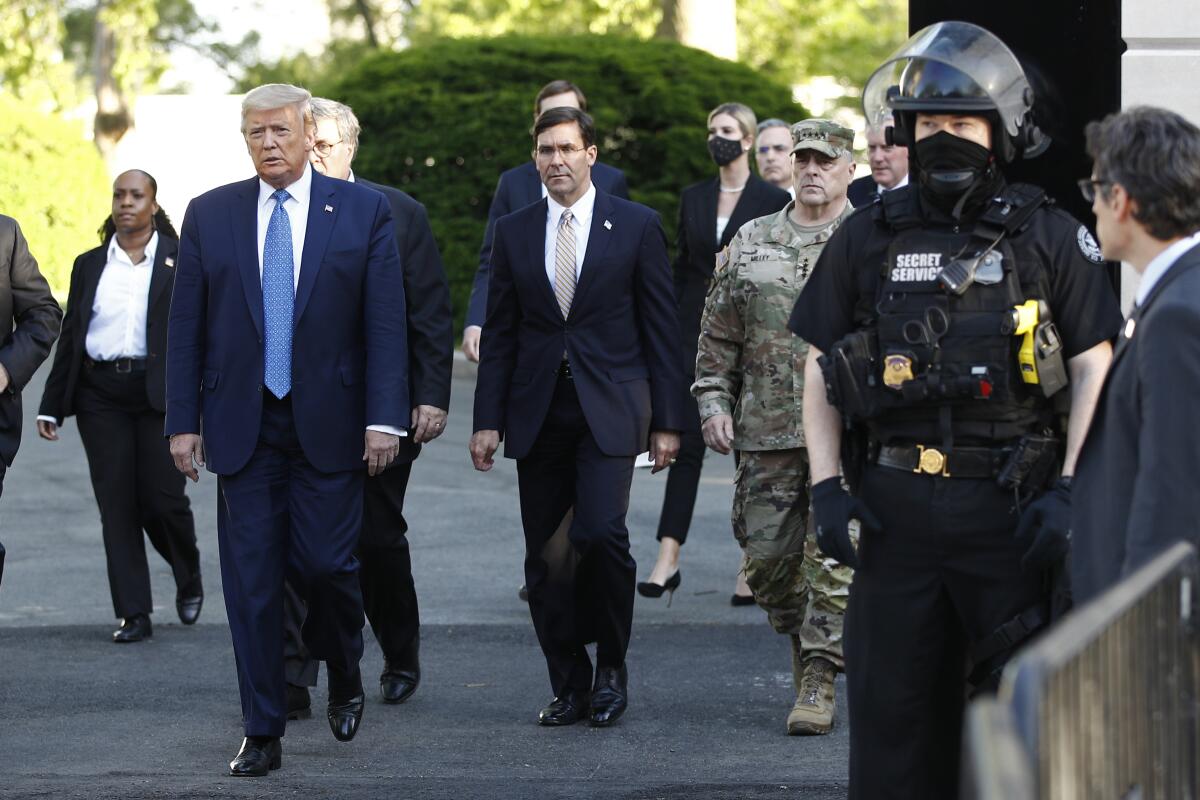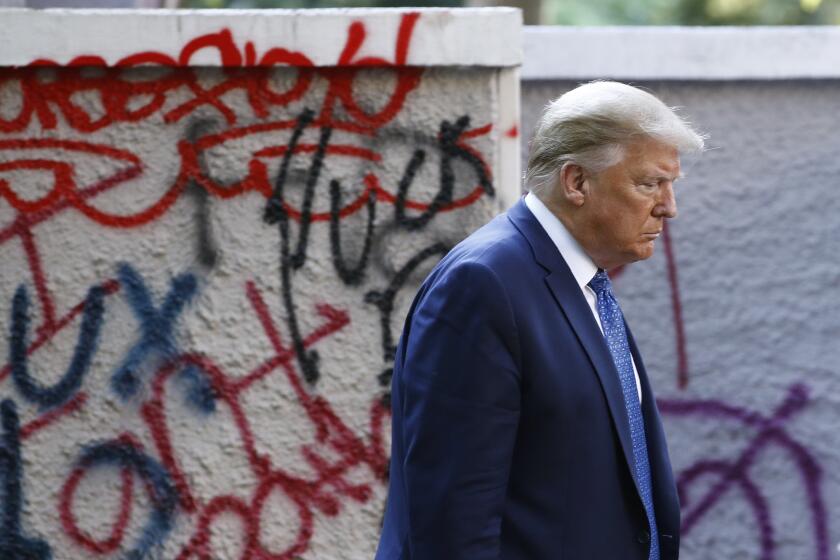Column: Trump finds an unexpected center of resistance: the Pentagon

- Share via
WASHINGTON — The leaders of the American military establishment drew a line in the sand last week, staging a polite but unmistakable rebellion against the dangerous impulses of President Trump.
And the rebels may be winning.
The most widely noted salvo came from former Defense Secretary James N. Mattis, who declared, after more than a year of silence, that Trump “does not even pretend to try” to unify the American people.
At odds with the military, snubbed by foreign leaders and trailing in polls, President Trump faces several crises worsened by his own miscalculations.
But Mattis wasn’t the only dissident — or even the most important one.
Trump’s Defense secretary, Mark Esper, rebuffed the president’s threat to deploy active-duty soldiers into American cities to quell the protests that have erupted since the killing of George Floyd by police in Minneapolis.
On Friday, Esper ordered regular Army units that were rushed to Washington early in the week to return to their bases in New York and North Carolina, de-escalating the sense of armed siege in the nation’s capital.
He also directed National Guard troops to patrol the city without weapons, despite Trump’s direction that they be “heavily armed.”
Gen. Mark A. Milley, the chairman of the Joint Chiefs of Staff, also weighed in, warning that the U.S. armed forces will not allow themselves to be used against nonviolent protests.
Every member of the U.S. military swears an oath to support and defend the Constitution, he wrote his commanders, “including the right to freedom of speech and peaceful assembly.”
The chiefs of staff of the Army, Navy and Air Force issued similar messages, reinforcing their fidelity to the Constitution and pledging to battle racism in their ranks.
A full-dress parade of retired officers spoke out as well. Milley’s predecessor as chairman of the Joint Chiefs, retired Army Gen. Martin E. Dempsey, warned that Trump’s threat to use troops would damage trust in the armed forces.
“Our fellow citizens are not the enemy,” he wrote.
It was an extraordinary moment — as if we were in a banana republic ruled by a would-be authoritarian, and the nation’s military leaders decided it was their job to preserve the Constitution.
The dissents from Esper and Milley were belated. They both accompanied Trump on his disastrous stroll to St. John’s Episcopal Church for a photo op, an embarrassing image they’re now trying to erase. They also both approved the initial decision to move 1,600 active-duty troops to bases near the capital.
But their public breaks with a notoriously vengeful president still qualified, at least in Washington, as modest acts of bureaucratic courage.
Unlike Mattis, they aren’t retired. They’re at the peak of their careers. They still face the daily challenge of managing the president’s demands. Their reputations are still at the president’s mercy.
At least, they were until last week. And that may be the point.
Esper and Milley have implicitly dared the president to fire them. That’s not an especially unusual act in Washington — but it’s normally done in private, where everyone can back down without fear of humiliation. It’s almost never done in public.
Esper’s defiance was especially notable since the former Raytheon lobbyist was widely viewed as a compliant aide-de-camp. He initially seemed to support Trump’s call for troops last week and even referred to the streets of Washington as a “battle space,” as if it were Fallujah or Kandahar.
But after he ran into massive resistance from the Pentagon officers’ corps, he switched sides.
If there’s anything uniformed officers hate, it’s being ordered to use force to solve a political problem without clear military objectives. The current generation learned that in Iraq and Afghanistan.
In this case, they faced a nightmare scenario: U.S. combat troops clashing with unarmed American civilians exercising their legal right to protest.
The episode laid bare a deeper divide.
When the president came to the White House in 2017, he believed the armed forces, which he frequently called “my military,” were part of his political base. He stuffed his administration with retired military officers — “my generals” — including Mattis.
But the generals didn’t simply salute and carry out his orders. They insisted on offering their professional advice and, on occasion, pushing back.
And they chafed at Trump’s casual portrayal of the armed forces as one of his personal political assets.
“I have the support of the police, the support of the military, the support of the Bikers for Trump — I have the tough people,” the president bragged in 2019.
That’s not how professional officers see their role. It’s not even an accurate reflection of their private views; a poll of military personnel last year found that they are only a little more supportive of the president than civilian voters, with 50% saying they view him unfavorably.
For the generals, this isn’t only about following the Constitution. It’s a matter of protecting the services in which they’ve made their careers.
The military is the most admired institution in American life, and they want to keep it that way. As a practical matter, they want their massive budget requests to win support from Democrats as well as Republicans.
And since roughly 40% of service members are people of color, they know they must make diversity work.
A standoff with Esper and Milley poses an unusual challenge for Trump — especially when he’s seeking reelection.
He reportedly doesn’t want to fire them. But leaving them in place makes him look less than the strongman he aspires to be.
Nothing says “internal chaos” more clearly than Cabinet officers or top aides refusing to fully carry out the president’s desires and publicly staking lines they will not cross.
But if you’re worried that Trump might refuse to leave office if he loses the November election, this is a good thing: a signal that he can’t count on the military to get his way. We’re not a banana republic yet.
More to Read
Get the L.A. Times Politics newsletter
Deeply reported insights into legislation, politics and policy from Sacramento, Washington and beyond. In your inbox three times per week.
You may occasionally receive promotional content from the Los Angeles Times.












